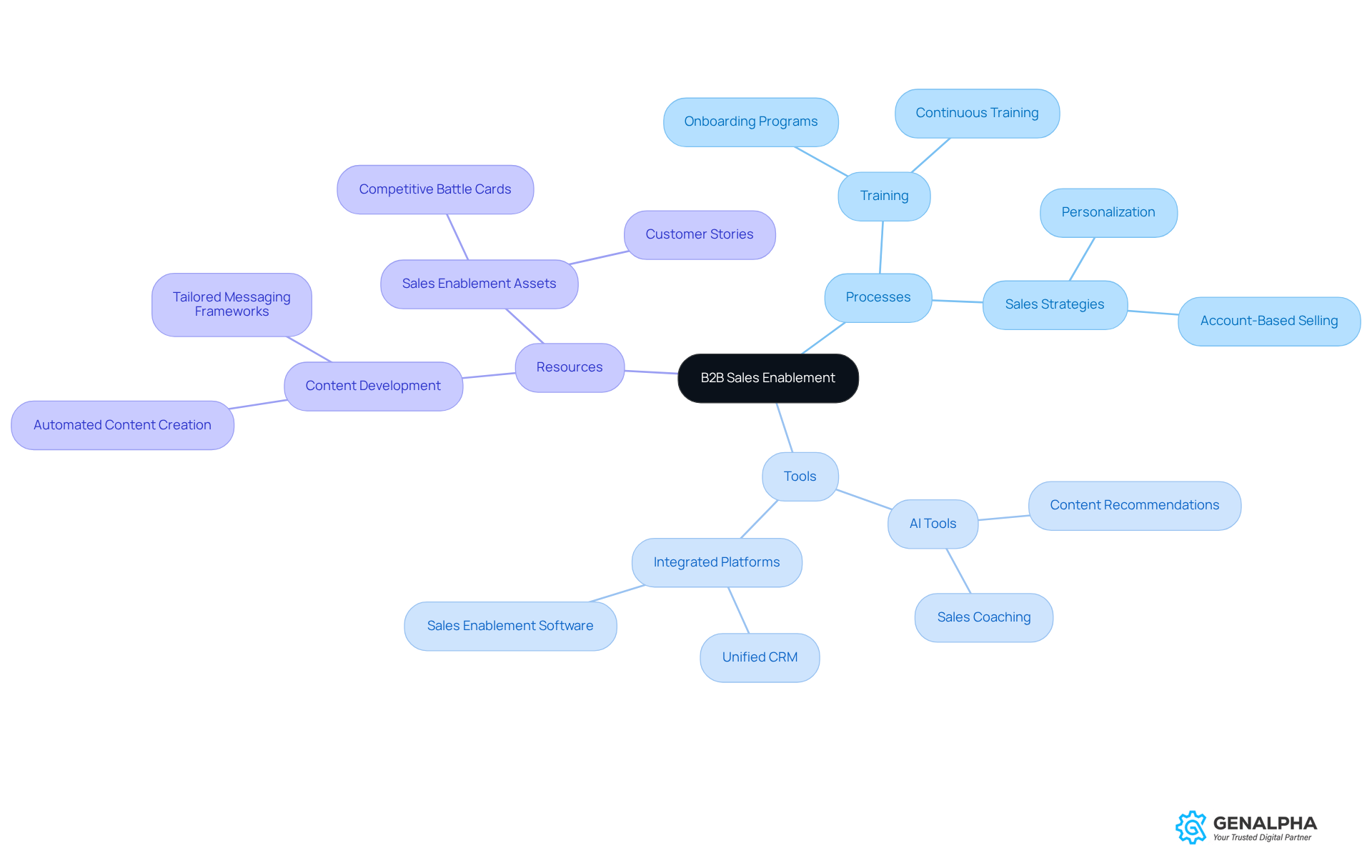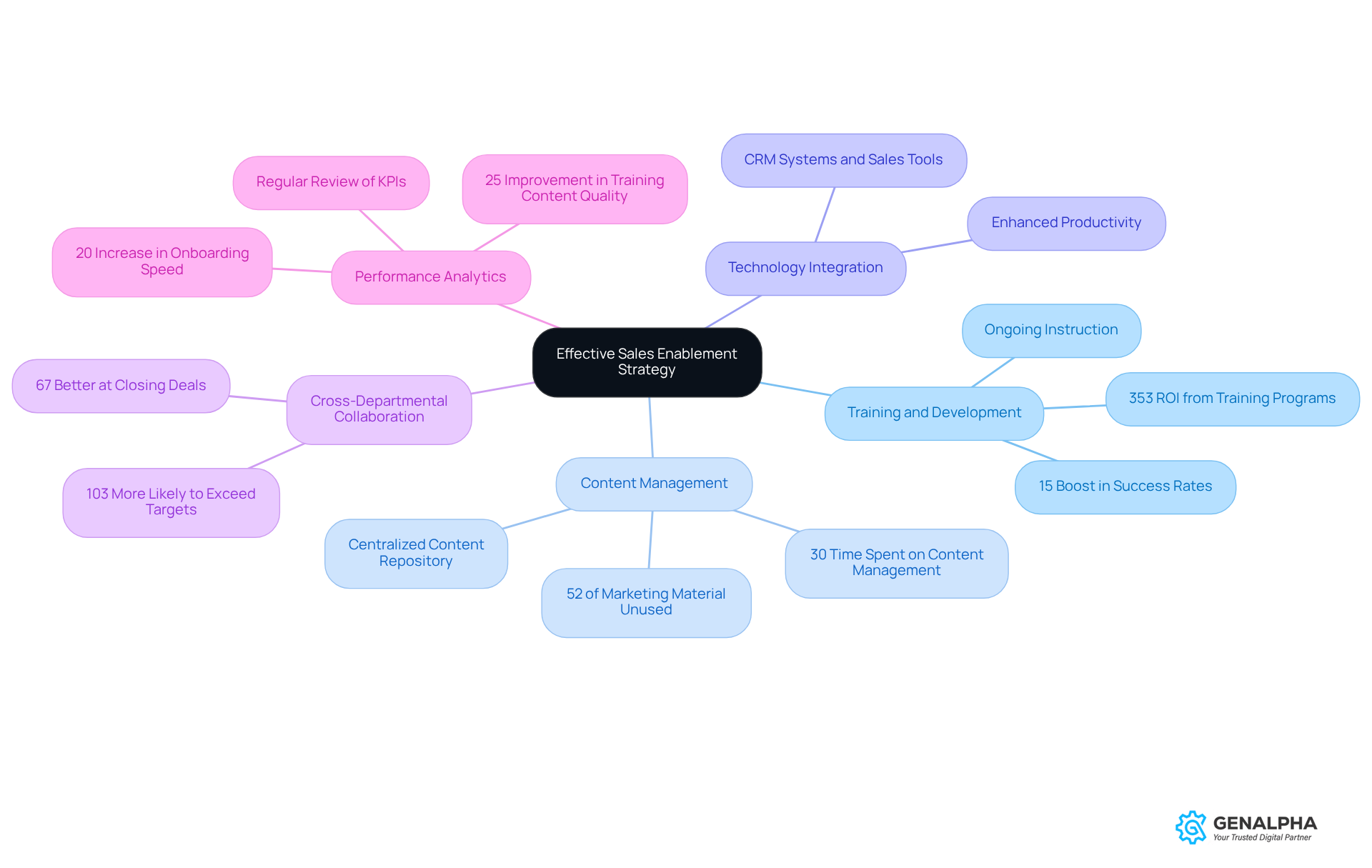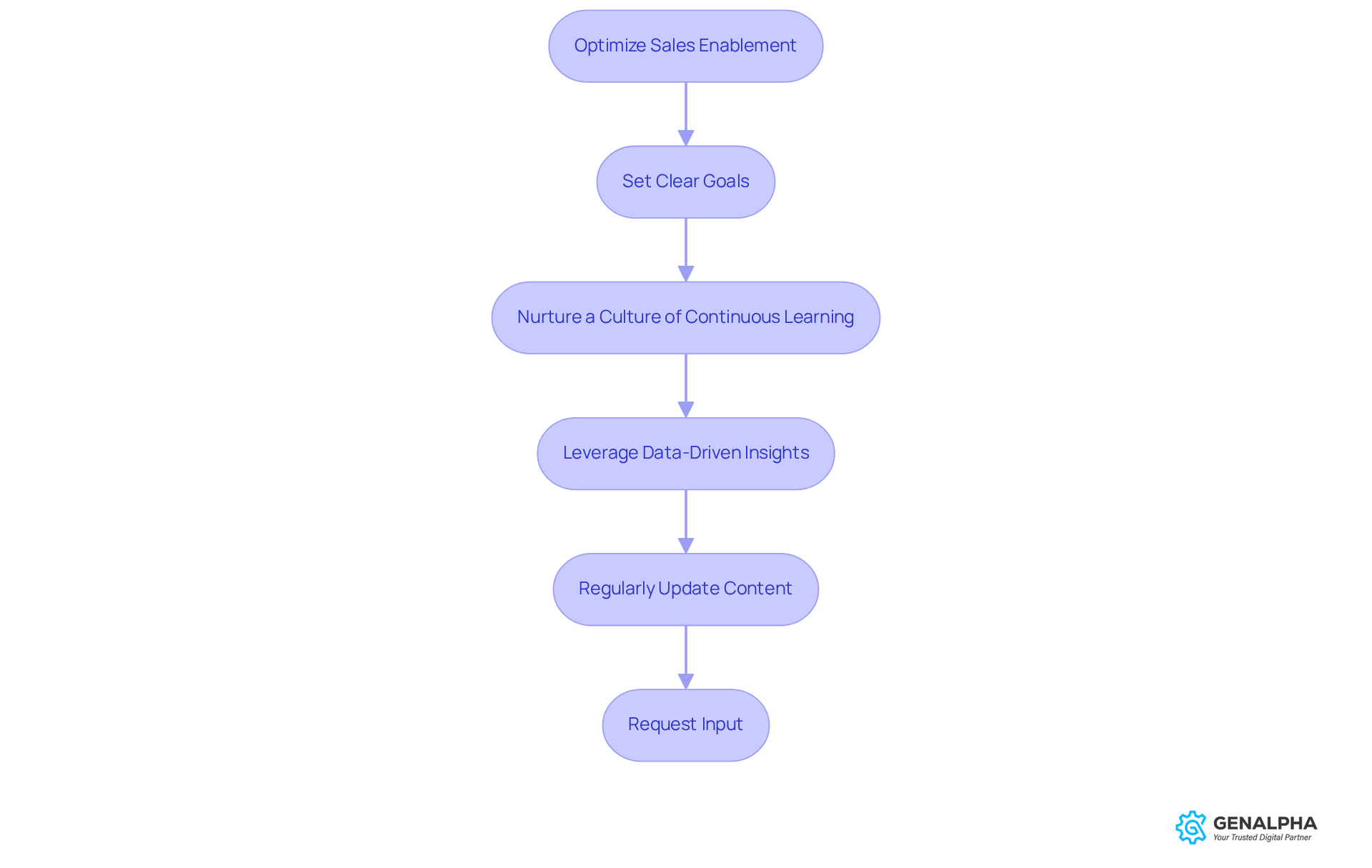Overview
Let’s talk about three key strategies that can really amp up your sales enablement game in B2B:
- Training and development
- Content management
- Technology integration
These strategies aren’t just buzzwords; they’re essential for enhancing communication and improving customer interactions. And guess what? They can also drive revenue growth! Statistics show that having organized enablement strategies can significantly boost your sales success rates and return on investment.
Think about it: when your team is well-trained and has access to the right content and tools, they’re more equipped to connect with customers effectively. For example, imagine a sales rep who knows exactly what to say and has all the resources at their fingertips. That’s the kind of confidence that translates into sales!
So, what’s stopping you from implementing these strategies? It’s time to take action and explore how these elements can transform your sales approach. Remember, the goal here is to create an environment where your team feels empowered to succeed. Let’s dive in and make sales enablement work for you!
Introduction
In the competitive world of B2B sales, engaging potential buyers is more important than ever. Think about it: sales enablement is like the backbone of this engagement. It gives teams the tools, training, and resources they need to connect meaningfully with their audience. As buyers increasingly lean towards self-service options, the real challenge is ensuring that sales reps not only grasp customer needs but also share valuable insights that build lasting relationships.
So, what strategies can organizations adopt to boost their sales enablement efforts and thrive in this ever-changing marketplace? Let's dive in!
Define B2B Sales Enablement and Its Importance
Sales enablement B2B focuses on the processes, tools, and resources that assist teams in connecting with potential buyers during their purchasing journey. Think of it as the behind-the-scenes magic that includes training, content development, and tech integration—all aimed at making the sales process smoother.
Why is sales support so crucial? Well, it enhances communication, improves customer interactions, and ultimately boosts revenue growth. In a world where buyers are leaning more towards self-service options, effective sales support ensures that teams can deliver valuable insights and connect meaningfully with their audience. This connection fosters stronger relationships and leads to higher conversion rates.
Here’s a startling fact: 59% of B2B purchasers feel that most sales reps don’t really take the time to understand their goals. This highlights just how important efficient sales enablement B2B is for understanding what buyers truly need. And looking ahead, by 2025, most B2B buyer interactions will happen online before any direct talks take place. This shift underscores the growing importance of digital engagement.
Organizations that focus on customer support are in a better position to adapt to these changing buyer expectations. For instance, 42% of top-performing companies are investing in automated content creation. However, it’s worth noting that nearly seven in 10 sales representatives feel overwhelmed by the multitude of tools they’re expected to use. This can make it tough to implement effective sales strategies.
So, how can companies address these challenges in the context of sales enablement B2B? By doing so, they can ensure they remain competitive in a fast-paced marketplace, achieving sustainable growth and enhancing overall performance. What steps can your organization take today to improve sales support?

Identify Key Components of an Effective Sales Enablement Strategy
An effective sales enablement strategy includes several key components that really make a difference:
-
Training and Development: Ongoing instruction is crucial for keeping sales teams informed about products, market trends, and customer needs. Did you know that companies with organized enablement strategies see a 15% boost in success rates? Plus, those investing in training programs average a whopping 353% ROI! This really highlights the financial benefits of continuous training on revenue achievement.
-
Content Management: Providing marketing teams with easy access to relevant content—like case studies, product sheets, and presentations—is essential for effective engagement. Statistics show that sales reps spend about 30% of their time managing content, and nearly 52% of marketing material goes unused. This points to the need for a centralized content repository to streamline efficiency and enhance sales enablement b2b, allowing sales teams to focus on what they do best—selling!
-
Technology Integration: Leveraging CRM systems and sales support tools can really streamline processes and offer valuable insights into customer interactions. Companies that embrace strong revenue-enhancing technologies benefit from sales enablement b2b, reporting better productivity and a more cohesive approach to customer engagement.
-
Cross-Departmental Collaboration: When marketing and customer support teams align, it creates a unified strategy for engaging customers, which enhances the overall experience. Organizations that focus on sales enablement b2b by prioritizing collaboration across these departments are 67% more successful at closing deals, and coordinated teams are 103% more likely to exceed their targets. This really shows how important teamwork is in achieving business goals.
-
Performance Analytics: Regularly reviewing performance metrics helps organizations identify areas for improvement and adjust strategies accordingly. Keeping track of key performance indicators (KPIs) like conversion rates and sales cycle times is essential for enhancing sales enablement b2b initiatives and driving sustainable growth. For instance, a global tech leader saw a 20% increase in onboarding speed and a 25% improvement in training content quality after implementing a revenue support strategy. This clearly demonstrates the tangible benefits of effective performance analytics.

Implement Best Practices for Optimizing Sales Enablement
To optimize sales enablement, let’s dive into some best practices that can really make a difference:
-
Set Clear Goals: It’s crucial to establish specific, measurable objectives for your revenue enablement initiatives. By using the SMART goal framework—Specific, Measurable, Achievable, Relevant, and Time-bound—you can align your goals with broader business objectives. For instance, aiming to boost qualified leads by 15% gives your team a clear target to rally around.
-
Nurture a Culture of Continuous Learning: Think about promoting ongoing training and development to keep your teams in the loop about industry trends and product knowledge. Organizations that prioritize continuous education often see enhanced performance. In fact, studies show that companies with a strong learning culture achieve higher success rates and experience lower employee turnover. For example, those investing in ongoing education report a 20% rise in performance.
-
Leverage Data-Driven Insights: Have you considered utilizing analytics to better understand customer behavior and preferences? This insight can help you tailor your engagement approaches, making your marketing initiatives more effective. For example, by monitoring material performance, you can discover which resources resonate best with potential clients, allowing for focused adjustments.
-
Regularly Update Content: Keeping your marketing materials current and relevant is key. They should reflect the latest product offerings and market conditions. A solid management approach can help maintain the quality and accessibility of your resources, enabling your teams to adapt quickly to changing customer demands. Companies with updated content have seen a 30% increase in engagement rates—pretty impressive, right?
-
Request Input: Don’t forget to consistently collect feedback from your sales personnel about the effectiveness of your enablement tools and resources. This feedback loop is vital for making necessary adjustments that enhance usability and impact, ultimately leading to better revenue results. Plus, fostering cross-functional collaboration between sales and marketing teams can really accelerate growth. Aligned teams experience 24% faster growth compared to those operating in silos.
So, what are you waiting for regarding sales enablement b2b? Let’s put these practices into action and watch your sales enablement B2B efforts soar!

Conclusion
Effective sales enablement in the B2B landscape isn’t just a trend; it’s a must-have for boosting sales team performance and driving revenue growth. Think about it: by honing in on the processes, tools, and resources that foster genuine connections with potential buyers, organizations can tackle the complexities of today’s sales environment more effectively. And as the purchasing journey moves increasingly online, having robust sales support is more critical than ever.
So, what are the key strategies for successful sales enablement? Well, comprehensive training and development, efficient content management, seamless tech integration, collaborative efforts across departments, and diligent performance analytics all play vital roles. Each component equips sales teams with the knowledge and resources they need to engage effectively with customers, leading to improved conversion rates and overall business success. The stats really highlight the importance of these strategies, showing tangible benefits like increased ROI and higher success rates.
We can’t underestimate the significance of implementing these best practices. By nurturing a culture of continuous learning, leveraging data-driven insights, and keeping content up-to-date, organizations can adapt to evolving buyer expectations and supercharge their sales enablement efforts. The call to action is crystal clear: businesses must prioritize these strategies to stay competitive and achieve sustainable growth in this ever-changing marketplace. Embracing effective sales enablement practices today will truly pave the way for success tomorrow.
Frequently Asked Questions
What is B2B sales enablement?
B2B sales enablement refers to the processes, tools, and resources that assist sales teams in connecting with potential buyers during their purchasing journey. It includes training, content development, and technology integration to make the sales process smoother.
Why is sales enablement important?
Sales enablement is crucial because it enhances communication, improves customer interactions, and boosts revenue growth. It allows sales teams to deliver valuable insights and connect meaningfully with buyers, fostering stronger relationships and higher conversion rates.
How do buyers feel about sales representatives in B2B transactions?
A significant 59% of B2B purchasers feel that most sales representatives do not take the time to understand their goals, highlighting the need for effective sales enablement.
What trends are expected in B2B buyer interactions by 2025?
By 2025, it is expected that most B2B buyer interactions will occur online before any direct conversations take place, emphasizing the increasing importance of digital engagement.
What challenges do sales representatives face regarding sales enablement tools?
Nearly seven in ten sales representatives feel overwhelmed by the multitude of tools they are expected to use, which can hinder the implementation of effective sales strategies.
How can organizations improve their sales enablement strategies?
Organizations can improve their sales enablement strategies by focusing on customer support, adapting to changing buyer expectations, and investing in tools such as automated content creation to remain competitive in a fast-paced marketplace.




